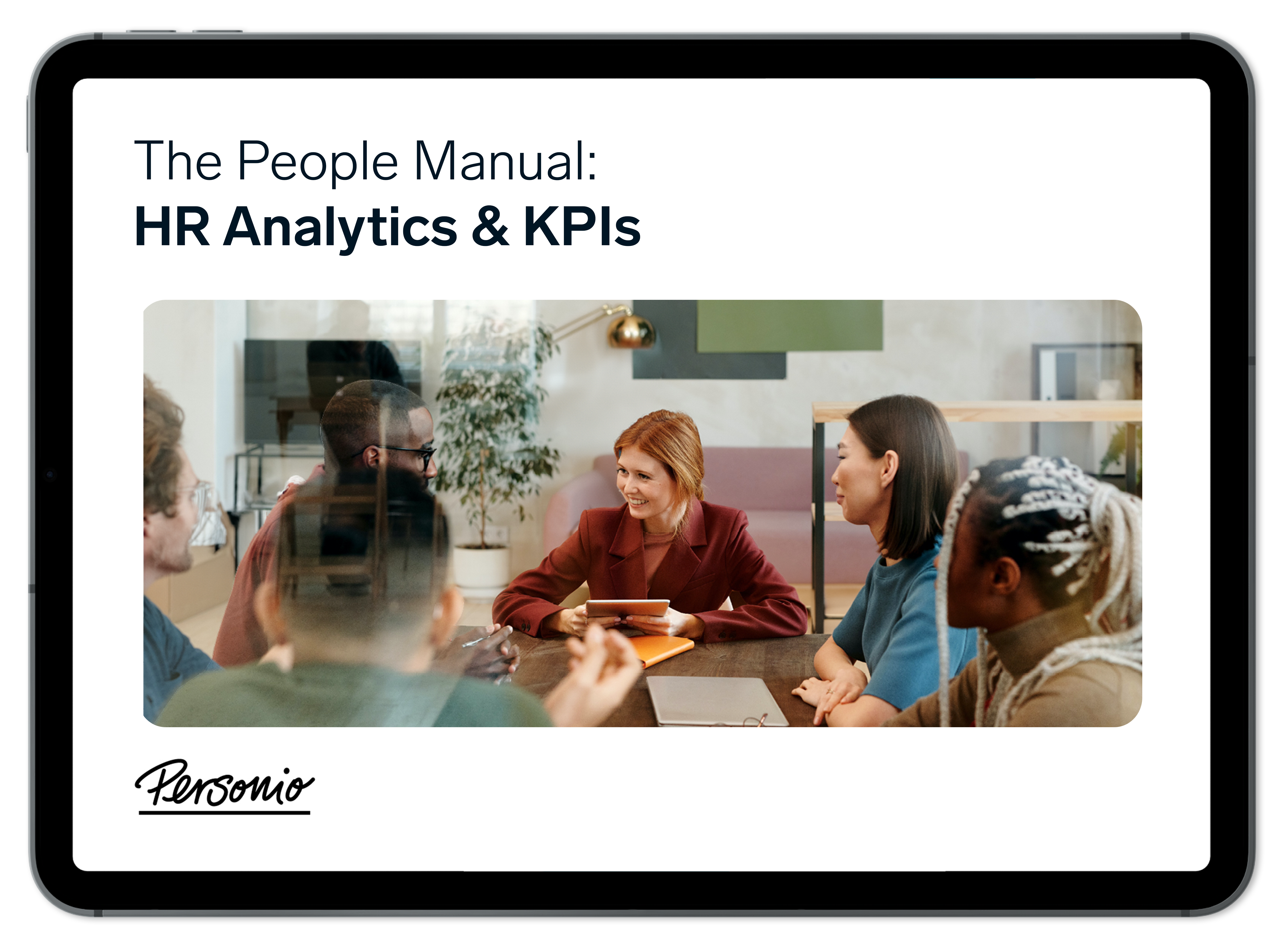
The Personio People Manual
Over a decade of expertise on HR analytics and critical KPIs.
Download your copy todayeNPS: Breaking Down Employee Net Promoter Scores

An employee net promoter score (eNPS) can help answer an age-old question: How do you know if your employees are engaged at work? According to one Gallup poll, having engaged employees can result in an 81% reduction in absenteeism, an 18–43% increase in turnover and a 10% increase in customer loyalty.
Clearly, the stakes are high. In this post, we’ll dive into one important metric that you should be tracking if you want to keep an eye on engagement within your organisation: your eNPS.
Make way for more progressive HR practices with Personio today.What Is eNPS?
Your Employee Net Promoter Score, or eNPS, is a simple metric that reflects how likely your employees are to recommend your company as a workplace. This gives you a general idea of their level of engagement, commitment and overall happiness at work.
Calculating Your eNPS
To calculate your organisation’s eNPS, you’ll need to send your employees a very simple survey with just one question: ‘On a scale of one to ten, how likely are you to recommend [your company] to your friends or family as a place to work?’
You’ll then separate your employees’ responses into the following categories:
Promoters: Those who give the company a score of 9 or 10.
Detractors: Those who give the company a score from 1 to 6.
Passives: Those who give the company a score of 7 or 8
Next, you’ll do a simple calculation, subtracting the percentage of detractors from the percentage of promoters. Passives aren’t counted in the calculation.
eNPS Benchmarking and Ranges
Because of the way it’s calculated, your eNPS score will be a whole number between -100 and 100. The higher the number, the better your eNPS.
Let’s consider some of the ranges of eNPS:
-100 – Your organisation is in serious trouble, as you have a vast majority of detractors.
-50 – Detractors still make up the majority of your organisation.
0 – If your score is 0, it helps to identify how many passive answers you had.
30 – This should be seen as the minimum standard for a successful eNPS.
50 – Your organisation is looking relatively healthy.
100 – Your organisation is in top shape.
Ideally, your eNPS should not slip below 30. But, every organisation and every industry is different, so you may need to benchmark it against similar companies.
eNPS Calculation Examples
Here are some examples of an eNPS calculation to help you understand how it works:
Example 1
Let’s imagine you run a company with 100 employees and want to work out your eNPS. You run a survey, and get the following results:
60 people give a rating of 9 or 10 (promoters)
20 people give a rating of 7 or 8 (passives)
20 people give a rating of 6 or below (detractors)
To work out your eNPS, you can discount the passives from your calculation. You’re then left with 60% promoters and 20% detractors. When you subtract the percentage of detractors from the percentage of promoters, you get an eNPS of 40.
Example 2
For our second example, let’s say you want to improve employee engagement at a larger company, with 2000 employees. You send out an eNPS survey and find that you have 600 promoters (30%) and 800 detractors (40%). The remaining 30% of your employees are passive, and therefore not counted in the calculation.
To calculate your eNPS, you subtract the percentage of detractors (40) from the percentage of promoters (30). This gives you an eNPS of -10. Since this is a negative number, it tells you that you have more detractors than promoters in your organisation.
The People Manual: HR Analytics & KPIs

Over half a decade of collected insights on everything related to the KPIs that drive success in HR. Grab your free copy right now.
Download your copy todayThree Top Benefits of Tracking eNPS
Here are some of the advantages of tracking eNPS for your organisation:
It’s easy for everyone: An eNPS survey is easy for managers to send out, and quick and easy for employees to complete. This means you’ll likely get a higher participation rate than you would with other types of surveys.
It’s simple to track: An eNPS survey gives you just one number instead of lots of complicated figures, making it an easy metric to track and compare over time.
It’s cost-effective: You can work out your eNPS easily, without having to spend time thinking up lots of questions. This means there’s no big commitment needed in terms of time or money.
Three Key Limitations of eNPS
eNPS does also come with some limitations. For example:
It’s just a metric: All your eNPS can do is give you an idea of how your employees are feeling — it can’t actually help you to improve engagement. Tracking eNPS is only useful if you’re also willing to put in the work to resolve any problems.
It doesn’t provide qualitative data: eNPS doesn’t give you any insights into why your employees have rated your organisation in a particular way. You might want to couple your eNPS with other, more qualitative surveys at different points in the year.
It doesn’t tell you everything: For example, many employees may be perfectly content at work, but not excited about it, putting them in the ‘passive’ category. A low eNPS doesn’t necessarily mean disaster — it just means you should do further analysis to find out what’s going wrong.
5 Key Ways to Improve Your eNPS Tracking
Here are a few tips for getting the most out of your eNPS tracking:
1. Measure Regularly and Consistently
While eNPS is a useful metric to track, one survey alone doesn’t actually tell you very much. What’s more useful is to track and compare your eNPS over time. By doing this at regular intervals such as every quarter, you can determine which events might have affected your score. Track your eNPS regularly and communicate it across your organisation!
2. Include a Follow-Up Question (But Only One)
eNPS can’t tell you why employees have given your organisation a particular score — unless you add a follow-up question. This question should be brief and open-ended, so employees can freely explain their reasoning. For example, you could include one of the below questions:
What was the main reason for the score you gave?
What is one thing that we could improve on as an organisation?
What would hold you back from recommending [company] to a friend?
To make sure your eNPS survey is still quick and easy to complete, it’s best to stick to just one follow-up question. Hold back on creating more work for respondents.
3. Ensure Anonymity (And Make This Clear To Employees)
If you want your employees to answer your eNPS survey honestly, you need to make sure they know it’s completely anonymous. If employees think their names will be attached to the score they give, they may give a higher rating than they really feel the company deserves, which could skew your results and be even more detrimental to your culture.
4. Be Honest and Communicate Results
For best results, you should be honest with your employees about the results of your eNPS survey — even if they reflect poorly on you. This shows people that you’re willing to listen to employee feedback and committed to improving.
5. Send Reminders
Since eNPS surveys are quick and easy to complete, they typically get a higher response rate than other surveys, even without reminders. However, your notification could still catch an employee at a bad time, so it’s a good idea to send a quick reminder over email or Slack to maximise your responses.
Alternatives To Tracking eNPS
If you want to get more in-depth information about how your employees are experiencing the workplace, you might want to consider sending out regular employee engagement surveys in addition to calculating your eNPS. These allow you to dig deeper into your employees’ engagement, satisfaction and alignment with the company’s goals and values.
Another option is to send out regular pulse polls, which are shorter surveys of about 5–15 questions. These allow managers to get a quick snapshot of an organisation, without employees having to spend a long time filling out a questionnaire. You can always dive in deeper with a more detailed survey if a pulse poll reveals something interesting.
eNPS FAQs
Still have questions about eNPS? Here are the answers to a few FAQs:
What Does eNPS Stand For?
eNPS stands for Employee Net Promoter Score.
What Is the Difference Between eNPS and NPS?
NPS stands for Net Promoter Score, and is a measure of customer loyalty and engagement. eNPS is different in that it measures the loyalty and engagement of employees, rather than customers.
What Is a Good eNPS Score?
eNPS scores vary widely based on factors including location, industry and company size, so what counts as a ‘good’ score will depend on your organisation. As a general rule, the higher your score, the better. A score above zero shows that you have more promoters than detractors in your organisation.
What Is the Formula For Calculating eNPS?
The formula for calculating eNPS can be expressed as: percentage of promoters (%) – percentage of detractors (%) = eNPS
Why Is eNPS Important?
Your eNPS gives you a quick read on how engaged and enthusiastic your employees are at work. It’s most useful when measured over time, as it can provide valuable insights into how organisational changes or new policies have affected morale within your workforce.
Dive Into Detailed Analytics With Personio
When you’re tracking any workplace metric, you need a way of accurately measuring data, creating reports, and sharing the results — and Personio can help.
Personio’s analytics features allow you to analyse data from HR reports at a glance, and drill down into the details when you need to. This means you can make confident, data-backed decisions that drive your business forwards, without having to wrestle with unwieldy Excel docs and complex datasets.
Book a demo or start your free trial today to find out more.

